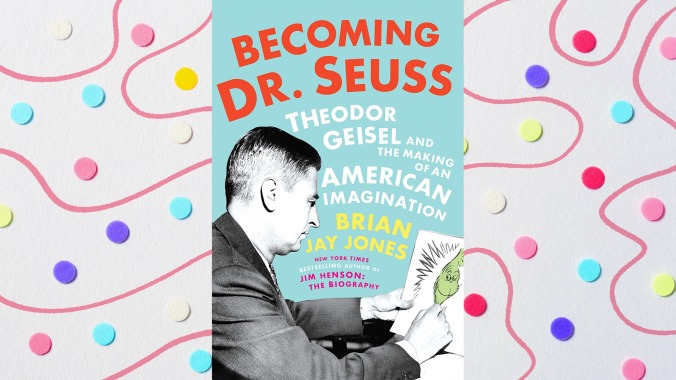Theodor Seuss Geisel, or Dr. Seuss as he was best known, published 60-plus children’s books in his lifetime—the publication of posthumous titles show no stopping. And nearly all adhere to the same basic plot: the protagonist encounters a new world (a new street, new zoo, new alphabet, an egg or pair of siblings to babysit) and chaos ensues (strange creatures! letters! and words!) set to rhyme. It’s an apt metaphor for adolescence, an age accented by the topsy-turvy, too-muchness of the world.
But contrary to the worlds he created, Geisel’s life was rather un-Seussian. He wrote with steadfast discipline, quietly traveled the world between books, filled ashtrays with the spent cigarettes that would kill him at the age of 87. Geisel quashed any entreaties to pen his memoirs, bemoaning that they “would become a source of irritation to the reader in a 200-page volume,” before grinchily groaning, “Who could possibly care about all these details?” Brian Jay Jones, that’s who. Jones, the author of lauded biographies of Jim Henson and George Lucas, takes up Geisel’s challenge, filling 400-plus pages with more details than McElligot’s pool has fish.
Becoming Dr. Seuss begins where else but Springfield, Massachusetts’s Mulberry Street, the setting for his first kids book, a series of “outlandish tales” in which young Marco turns “minnows into whales.” He wrote and illustrated for the college humor magazine at his beloved Dartmouth College, where Geisel’s classmates voted him Class Wit and Least Likely To Succeed. He moved to Oxford, England in hopes of earning a PhD in literature, and met a girl with a most Seussian “lopsided smile” who encouraged him to quit the classroom for cartooning back home. Like Warhol after him, Geisel first succeeded in commercial advertising, drawing punny toons for Flit insecticide, Esso motor oil, and Schaefer beer, among other corporations. Many of these ads would foretell the menagerie to follow: human-eyed fish, bizarro birds, all-knowing elephants, elaborately whiskered humans, and vaguely feline creatures.
After releasing four books to lackluster sales, Geisel struck gold in 1940 with Horton Hatches The Egg, the story of an ever-faithful elephant who braves storms, ridicule, hunters, and the circus to hatch the titular ovoid. Though Geisel would repeatedly claim that most of his book carried no moral message— “What’s wrong with kids having fun reading without being preached at?” he bellyached—reviews praised Horton’s stick-to-itiveness, an allegory ripe for the anti-appeasers of the early Second World War era.
During the war, Geisel couldn’t help but showcase his progressive leanings in an upturned world. He churned out hundreds of political cartoons for the leftist PM newspaper, and in 1943 joined the Army’s Signal Corps. Under the leadership of lieutenant colonel Frank Capra, one of Hollywood’s most successful directors, Geisel helped write propaganda documentaries and the Private Snafu series of cartoon shorts, which collected an all-star lineup of talents, including animation wizards Chuck Jones, Friz Freleng, Mel Blanc, and Ray Harryhausen.
Beginning in 1950, Geisel assembled arguably one of the most fecund and financially successful decades in the history of artistic expression, a period bookended by Yertle The Turtle And Other Stories—in which the authoritarian Yertle is a stand-in for Hitler—and Green Eggs And Ham—Seuss’ bestselling book, at over eight million copies sold. In 1957, Geisel unleashed two of literature’s most enduring characters in The Cat In The Hat and How The Grinch Stole Christmas! America had become Seussville.
But Geisel’s life wasn’t all Shmoopity-Shmoop, if you know your Lorax lingo. Half hagiography, Jones’ book is unafraid to recount the Schloppity-Schlopp that marred Geisel’s long career: The racist and misogynist cartoons penned during his early years. His dictatorial behavior while co-running the Beginner Books imprint. The absence of female protagonists in his books. And, most heartbreakingly, the suicide of his saintly wife, Helen, who swallowed a half-bottle of barbiturates in 1967, at the age of 69, after learning of Geisel’s affair with a woman whom he would marry the following year.
Beyond that, you won’t find much drama in these pages. Nor will you find deeper interpretations of Geisel’s work, or an analysis on how the past three decades, following his death in 1991, have treated his reputation and oeuvre. In the end, Becoming Dr. Seuss feels both like too much and too little. Still, Jones manages to craft a loving portrait of a singularly imaginative life, a life that seemed simultaneously big and small. How you’ll feel about Jones’ own penchant for too-muchness will depend on your post-adolescent adoration for Dr. Seuss. Would you still read him on a boat? With a goat? In the rain? On a train? In Korea? You get the idea.


 Keep scrolling for more great stories from A.V. Club.
Keep scrolling for more great stories from A.V. Club.